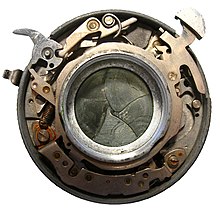
A rangefinder camera is a camera fitted with a rangefinder, typically a split-image rangefinder: a range-finding focusing mechanism allowing the photographer to measure the subject distance and take photographs that are in sharp focus. Most varieties of rangefinder show two images of the same subject, one of which moves when a calibrated wheel is turned; when the two images coincide and fuse into one, the distance can be read off the wheel. Older, non-coupled rangefinder cameras display the focusing distance and require the photographer to transfer the value to the lens focus ring; cameras without built-in rangefinders could have an external rangefinder fitted into the accessory shoe. Earlier cameras of this type had separate viewfinder and rangefinder windows; later the rangefinder was incorporated into the viewfinder. More modern designs have rangefinders coupled to the focusing mechanism so that the lens is focused correctly when the rangefinder images fuse; compare with the focusing screen in non-autofocus SLRs.
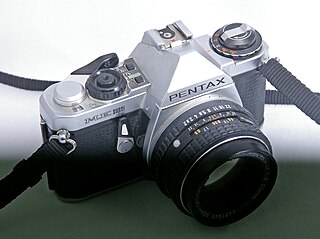
In photography, flash synchronization or flash sync is the synchronizing the firing of a photographic flash with the opening of the shutter admitting light to photographic film or electronic image sensor.

Cosina Co., Ltd. is a manufacturer of high-end optical glass, optical precision equipment, cameras, video and electronic related equipment, based in Nakano, Nagano Prefecture, Japan.

Rollei was a German manufacturer of optical instruments founded in 1920 by Paul Franke and Reinhold Heidecke in Braunschweig, Lower Saxony, and maker of the Rolleiflex and Rolleicord series of cameras. Later products included specialty and nostalgic type films for the photo hobbyist market.

Schneider Kreuznach is the abbreviated name of the company Jos. Schneider Optische Werke GmbH, which is sometimes also simply referred to as Schneider. They are a manufacturer of industrial and photographic optics. The company was founded on 18 January 1913 by Joseph Schneider as Optische Anstalt Jos. Schneider & Co. at Bad Kreuznach in Germany. The company changed its name to Jos. Schneider & Co., Optische Werke, Kreuznach in 1922, and to the current Jos. Schneider Optische Werke GmbH in 1998.

The Rolleiflex SL35 is a range of SLR cameras manufactured and sold by the German camera maker Rollei from 1970 to 1982. This range of cameras uses 35mm film. The camera bodies were initially made in Germany. After Zeiss Ikon discontinued camera production, Rollei acquired the Voigtländer brand and camera designs in 1972, and began producing a second generation of SLR cameras in Singapore starting from 1976. Some of those second-generation cameras were rebranded and marketed as Voigtländer VSL.

Retina was the brand-name of a long-running series of German-built Kodak 35mm cameras, produced from 1934 until 1969. Kodak Retina cameras were manufactured in Stuttgart-Wangen by the Kodak AG Dr. Nagel Werk which Kodak had acquired in December 1931.

The Contaflex series is a family of 35mm Single-lens reflex cameras (SLR) equipped with a leaf shutter, produced by Zeiss Ikon in the 1950s and 1960s. The name was first used by Zeiss Ikon in 1935 for a 35mm Twin-lens reflex camera, the Contaflex TLR; for the earlier TLR, the -flex suffix referred to the integral reflex mirror for the viewfinder. The first SLR models, the Contaflex I and II have fixed lenses, while the later models have interchangeable lenses; eventually the Contaflexes became a camera system with a wide variety of accessories.
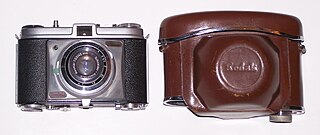
Kodak Retinette is the name of a classic series of cameras manufactured by the Eastman Kodak company. They were introduced in 1939 as a less expensive alternative to the Kodak Retina series. The first models were of the folding type using bellows and their lenses had three elements as compared to the four element Tessar lenses of the Retina series. The first non-folding (rigid) variant was introduced in 1954 with the model 022. They most often featured Schneider Kreuznach Reomar lenses but, sometimes, Rodenstock Reomar lenses were installed. The Rodenstock lenses were based on the original Schneider Kreuznach triplet design. Kodak Anastigmat Angénieux lenses were also used especially for the French market. Common shutters included Compur–Rapid as well as various Pronto, Vero and Kodak models.
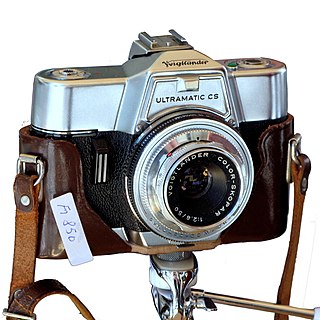
The Voigtländer Ultramatic CS was the first 35mm leaf shutter SLR camera with TTL metering. The design of the not too heavy camera was derived from the Voigtländer viewfinder cameras, with rounded sides and a shifter on the front side as shutter release. Its designer was Walter Swarofsky. A specialty of the camera was that shutter speed and aperture were controlled by rings around the bayonet. The lenses had only a distance control ring. The bayonet is a variant of the Deckel bayonet (DKL) offering mechanical control of both, aperture release and automatic aperture setting. The Septon 1:2/50mm was a well regarded lens, and like the Skopagon 2.0/40mm it was a quite fast lens for that type of SLR. The exposure delay was only 1/50 sec.

The Kodak Retina Reflex is a discontinued series of four single-lens reflex cameras made by Kodak in Germany between 1957 and 1974, as part of the Kodak Retina line of 35mm film cameras.

The Bessamatic was a line of 35mm SLR cameras made by Voigtländer in the 1960s, featuring a selenium meter. It uses a leaf shutter, similar to competing SLR cameras manufactured by Kodak and Zeiss Ikon in Germany, rather than the focal plane shutter almost universally adopted by Japanese SLRs such as the contemporary Nikon F and Pentax Spotmatic. The Bessamatic was supplemented by the Ultramatic in 1963, which used the same lens mount and added a shutter-priority autoexposure mode.
The design of photographic lenses for use in still or cine cameras is intended to produce a lens that yields the most acceptable rendition of the subject being photographed within a range of constraints that include cost, weight and materials. For many other optical devices such as telescopes, microscopes and theodolites where the visual image is observed but often not recorded the design can often be significantly simpler than is the case in a camera where every image is captured on film or image sensor and can be subject to detailed scrutiny at a later stage. Photographic lenses also include those used in enlargers and projectors.
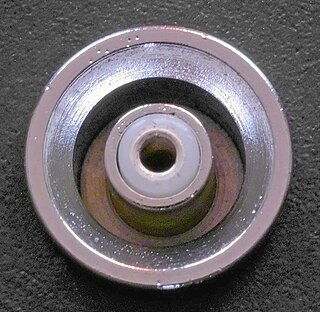
A Prontor-Compur connection is a standard 3.5 mm (1/8") electrical connector used in photography to synchronize the shutter to the flash.

The Mecaflex is a 35mm SLR camera for 50 exposures of 24 × 24 mm. It was presented at the photokina in Cologne in 1951, and launched commercially about two years later. The design is by Heinz Kilfitt, who is also known for designing the original Robot camera and the Kowa Six.

Rodenstock Photo Optics traces its origins to a mechanical workshop founded in 1877 by Josef Rodenstock and his brother Michael in Würzburg, Germany. The company relocated to Munich by 1884 and became an important manufacturer of both corrective lenses for glasses and camera lenses by the early 1900s. These two lines began to diverge in the 1960s as the center of photographic lens manufacturing shifted to Japan; the ophthalmic business continued as Rodenstock GmbH while the remaining camera lens business was repositioned to serve the large format and industrial precision optics markets, then spun off in 1996 as Rodenstock Präzisionsoptik. Since then, the precision optics brand has been acquired in succession by LINOS Photonics, Qioptiq Group, and Excelitas Technologies (2013).

Icarex is a line of 35mm single lens reflex cameras (SLRs) made by Zeiss Ikon, derived from an earlier Bessaflex project developed by Voigtländer. The Icarex line, which included the Icarex 35, Icarex 35CS, Icarex 35S, and SL 706, was aimed at a mid-range market above the Contaflex SLR, which was intended for advanced amateurs, but below the Contarex line for professionals.

The Vitessa was a line of 35mm compact rangefinder cameras made by Voigtländer in the 1950s, equipped with leaf shutters, similar in concept to and marketed against the competing Kodak Retina cameras manufactured by Kodak. Most of the Vitessa cameras were fixed-lens models equipped with collapsable lenses for portability. One of the later Vitessa models, the Vitessa T (1956), introduced the Deckel (DKL) bayonet mount for interchangeable photographic lenses.

Prominent refers to two distinct lines of rangefinder cameras made by Voigtländer.

The Vito and Vitomatic, Vitoret, and Vito Automatic were several related lines of 35 mm compact viewfinder and rangefinder cameras made by Voigtländer from the 1940s through the early 1970s, equipped with leaf shutters, similar in concept to and marketed against the competing Kodak Retina cameras manufactured by Kodak. All of these cameras were fixed-lens models; the models in the Vito line identified with Roman numerals were equipped with folding mechanisms and collapsible lenses for portability, while the others were rigid, non-folding cameras.

